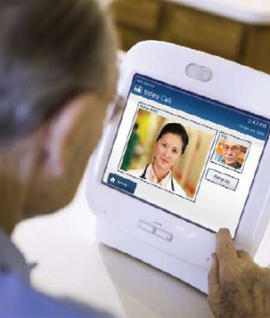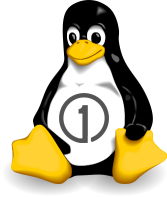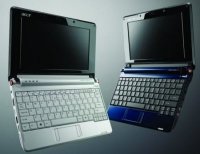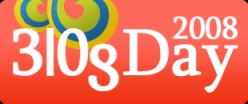Open Source is not rocket science, or is it?
If we look at Bugzilla’s mascot (called Buggie) most of us would immediately think that this software can’t be anything serious… and the same happens with many other open source projects that are underestimated by many executives and IT managers.
In this case, the issue tracking software from the Mozilla Foundation was adopted (and adapted) by the NASA with the help of Everything Solved. In my opinion, this is a great example of how OSS can bring benefits for the enterprise, as well as generate business.
Although there is a long list of commercial and non-commercial organisations using this software, what is most interesting is that a complex organisation involved in billion dollar projects like the NASA has trusted on this software. Read more »
Integrating mobility into healthcare
I have recently read about the launch of Intel’s new tele-healthcare device, the Health Guide PHS6000 and that made me think about the new posibilities that are emerging fast and that it seems like, finally, several technologies are becoming mature to the point of being able to transform the concept of healthcare.
Intel’s device is the result of a continuous effort from the company in this area, after having collaborated with Motion Computing in developing the C5 Mobile Clinical Assistant, that I also mentioned here.
Another sign of this new tendency is the recent release of the Panasonic Toughbook H1, a device with similar specs to the C5. Both of them have been specifically designed for hospital and clinical use, having specifications like MIL-STD-810F for withstanding three foot drops and IP54 rated for moisture and dust, and being able to be used in docking stations, wall mounted or even in mobile carts.
One of the interesting characteristics of these devices is the broad connectivity options. Some of them are: WiFi, Bluetooth, 3G, RFID, with optional GPS and barcode scanner plus a web camera. All of these aspects open a wide range of possibilities that we will probably start to see, like vitals capture and electronic medical records. Read more »
Buenos usos de la Web 2.0
Hace mucho tiempo que no escribo en el blog, y quiero darle prioridad a un tema que es más importante que todo lo que he escrito hasta ahora.
En esta ocasión, quiero hablar de un ejemplo de buen uso del poder de la web 2.0, las redes sociales y demás tecnologías. En concreto, se trata de ayudar a los demás (de múltiples formas).
Mientras que una gran mayoría de las ONG y demás entidades de ayuda siguen utilizando métodos «1.0» (campañas televisivas, por email, con publicidad en espacios públicos) para recolectar dinero/ayudas, eso es cada día más difícil, por la distancia que existe entre el que da la ayuda y el que la recibe y por la sensación de opacidad sobre el manejo de las ayudas. Read more »
Mobile Monday Madrid: being part of innovation
Today I had the opportunity to attend once again to the Mobile Monday Madrid. The topic for this meeting was Mobile Internet Platforms. For this occasion we had a great panel of speakers and also a great audience. The session was opened by Enrique Dans and after that we had speakers from the GYM (Google, Yahoo and Microsoft) who told us about their efforts to be the next biggest platforms for mobile devices.
After listening to their presentations about how they consider that the «new» connected life will be, and how they are positioning themselves to be the center of those connected lives, I was thinking about their strategies and took some notes that I would like to share with everyone.
Read more »
OneLinux: El Acer Aspire One a hombros de gigantes
En el mercado de los productos tecnológicos es cada vez más importante el crear o fomentar una comunidad de usuarios en torno a los productos. De esta manera, los usuarios podrían realizar aportaciones para mejorar sus productos e incluso colaborar en la estrategia de desarrollo ya que, en estos casos, nadie sabe más sobre un producto que sus propios usuarios!!!
Es por ese motivo que no entiendo bien las estrategias de diversos fabricantes de ordenadores a la hora de apostar por venderlos con distribuciones basadas en GNU/Linux preinstaladas, pero que no son 100% compatibles con alguna distribución «madura» que cuente con una comunidad importante de usuarios, y que pueda garantizar la evolución de dicha distribución, más allá de las capacidades de la empresa… que probablemente nunca puedan estar a la altura de una comunidad bien organizada de usuarios «comprometidos». Read more »
Los UMPC/Netbook: un producto disruptivo?
Me gusta analizar en lo posible cómo van evolucionando los mercados tecnológicos y cómo los afectan las innovaciones, la aceptación por parte de los usuarios y los movimientos de los demás agentes alrededor de ellos.
Hace unos días compré un mini-portátil (o UMPC / Netbook / etc.) Acer Aspire One, con la intención de tener un ordenador «realmente portátil» que me permita hacer el 90% (o el 100%) de las cosas que hago habitualmente (escribir en el blog, navegar por internet, escribir correos, leer documentos, tomar notas o hacer algún mapa mental con ideas, etc.)
Lo que me gustó del Aspire One es que tiene el mismo tamaño de pantalla que el Asus Eee PC 901, pero el teclado es un poco más grande (95% del tamaño normal), lo que me permite escribir con la misma velocidad que un teclado normal y además el disco es de 120Gb, por lo que puedo almacenar música, videos, etc. sin preocupaciones de espacio. Read more »
Blogday 2008: connecting people
Today is the Blog Day 2008, a day that has been selected because of the «similarity» of the 31-08 date with the word BLOG (You can see it more clearly on the image).
The objective of this day is to recommend new blogs in order to impulse their growth of those blogs that are considered interesting and worth reading, as well as to generate new conections among bloggers, to further enrich the blogsphere.
From this small corner of the blogsphere, I would like to recommend 5 blogs that are not new for me, but that I consider interesting and are not very related with the subject of this blog, but that I occasionally read to breath some «fresh air». Read more »
Blog Day 2008: connecting people
Hoy es el Blog Day 2008, un día que se ha elegido por la «similitud» de la fecha 31-08 con la palabla BLOG (se ve más claro en la imagen).
El objetivo de este día es el de recomendar nuevos blogs para fomentar el crecimiento de aquellos blogs que sean interesantes y generar conexiones entre bloggers, que es lo que enriquece la blogsfera.
Yo por mi parte, quiero aprovechar para recomendar 5 blogs que no son nuevos para mí, pero que considero interesantes y no están demasiado relacionados con la temática de este blog, pero que leo ocasionalmente para variar un poco la temática. Read more »
Innovative Cities for the Next Generation (ICING)
Some time ago I had the opportunity to participate in the closing event of the ICING (Innovative Cities for the Next Generation) european project in which T-Systems has participated, together with other companies and public institutions.
The project has taken place simultaneously in three european cities (Barcelona, Dublin and Helsinki) with the objetive of developing a bi-directional and multimodal communication platform within the citizens and between them and the public administration, aming also at developing some ground work for other cities that wish to apply innovative solutions to improve the life of its citizens.
In this occasion, I would like to share with everyone some of the conclusions that have been exposed and also to give my opinions, especially with regard to mobile technologies. Read more »
Innovative Cities for the Next Generation
Un tiempo atrás he tenido la oportunidad de participar en el evento final del proyecto europeo ICING (Innovative Cities for the Next Generation) en el cual ha participado T-Systems, junto con otras empresas e instituciones públicas.
El proyecto se ha desarrollado simultáneamente en tres ciudades europeas (Barcelona, Dublin y Helsinki) con el objetivo de desarrollar una plataforma de comunicación bi-direccional y multimodal entre los ciudadanos y las administraciones, buscando además sentar ciertas pautas para otras ciudades que quieran aplicar soluciones innovadoras para mejorar la vida de sus ciudadanos.
En esta ocasión, me gustaría compartir con todos algunas de las conclusiones que se han expuesto y dar mi opinión al respecto, sobre todo en lo que respecta a las tecnologías móviles. Read more »
 Comments (2)
Comments (2)







 Show only posts in english
Show only posts in english Mostrar sólo posts en español
Mostrar sólo posts en español






